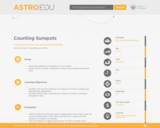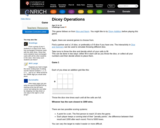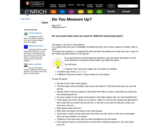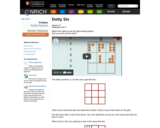
Children will practice friendship skills as they join activities or invite others to join them in their play.
- Subject:
- Health Education
- Material Type:
- Activity/Lab
- Game
- Lesson
- Lesson Plan
- Author:
- Utah Lesson Plans
- Date Added:
- 08/04/2022

Children will practice friendship skills as they join activities or invite others to join them in their play.

Test your attention to UI details by picking the design that is most correct.

Children will learn how to correctly hold a book, notice the spacing between words, tie illustrations to text, and track the words with a finger. Children will demonstrate that reading is done left to right, top to bottom, and front to back.

Children will talk about and measure ingredients to make fry bread.

This Flash game develops students' computational fluency and flexibility. It can be played alone or with others. Players choose 6 face-down number cards, and the applet provides a target number. Number cards include one each of 25, 50, 75, and 100, and multiple copies of 1 to 10. The goal is to use the selected numbers and the four basic operations (addition, subtraction, multiplication, division) to arrive at the target. Players can ask the applet to Show a Solution, although others may be possible. Several rule and scoring variations are suggested. A full screen option facilitates use on an interactive board. (This game is not self-checking.)

Using solar images and date obtained from Astronomical Observatory of the University of Coimbra lets you study the sunspots and their behaviour over days.

In this new version of Court Quest, jump on the Justice Express and help guide ordinary citizens who are looking for justice through local, state and federal court systems.

This article introduces a free online collection of images, video clips, and animations that teachers can use in creating resources for use with students. The four steps in creating a video clip, an animation, or other resource are presented.

Children will help create some rules to feel safe in their environment. Children will be able to recognize and state rules they helped create.

Sabotage a play area and seek input from your child(ren) to help problem-solve a solution. Remove a preferred play item and ask them what they could replace it with. Ask them to tell you what they are planning to build and predict what the outcome will be.

Children will move around in a designated area as they move like the animals in the story.

Children will listen to music and move their bodies to express the feelings of the music piece(s) presented.

Review the environmental factors that make the Earth habitable and compare them to other worlds within our Solar System. Use creative thinking to design an alien life form suited for specific environmental conditions on an extra-terrestrial world within our Solar System.

This collection of 6 games develops place value, operation sense and fluency, estimation, and strategic thinking. It is played on paper with a 6- or 9-sided die (printable pdf game sheets included). Players choose a game grid with empty cells representing the digits of a computation (addition, subtraction, multiplication, or division). They take turns rolling a die and placing the resulting number in a cell on their own grids. The goal is to create a sum/difference/product/quotient that is closest to a target number. Variations include using a decimal point and scoring options. Teachers' Notes include suggestions for introducing the game, discussion questions, support suggestions, and a link to a more challenging extension (Countdown, cataloged separately).

This lesson plan was an assignment created for the Digital Citizenship class. The materials used in this lesson plan were gathered from Common Sense.Students share a lot of information whenever they go online -- sometimes on purpose, sometimes not. They do not understand that online privacy isn't just what they say and post. This lesson will help students learn about tips they can take to share what others find and see about themselves online.

In this lesson students will use geogebra and other tools to discover how to calculate the slope of a line. They will also recognize lines that have 0 and undefined slope.

In this lesson, students will review decimal division as we prepare for our end of unit test. This will include dividing whole numbers by decimals, decimals by decimals, and decimals by whole numbers.

This game for two or more players tests students' knowledge of the uses of various measuring tools. An interactive spinner picturing 8 tools that measure the attributes of length, weight, volume, angle and time determines the players' movement on a game board. Students must explain their reasoning about their choices of tool applications. A printable page is available.

This dice game combines practice with basic number facts with strategic thinking. Students first are challenged to determine the rules of the game by watching a video of a game being played. The game is accompanied by a Teachers' Resource page that includes suggestions for approaching the problem, questions, extension ideas, and tips for support.

Children will act out the story with a beginning, middle, and end. Children will be able to identify body parts, review and label several color words, and use rhyming to predict what will be painted next.